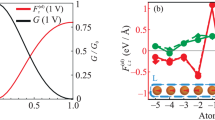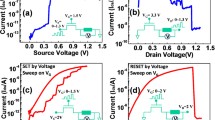Abstract
Electro-formation in metal insulator metal (MIM) structure causes the emergence of the conductive filament and also leaves a tiny insulating gap amid upper electrode and conductive filament. Since the material property of conductive filament is unlike that of the upper electrode, it is vital to consider these dissimilarities of electrodes in tunneling phenomena. In this paper, the trapezoidal potential barrier of an insulating film sandwiched between two dissimilar electrodes (asymmetric MIM) is accounted for and superimposed with triangular, parabolic and rectangular image force potentials, to derive the corresponding mean barrier heights. Then, the impact of the insulating film thickness, metal’s work function difference, and the dielectric constant of the insulating film on tunneling current density are investigated, employing the same mean barrier potential. Finally, the obtained results are implemented in conductive filament-based memristor model to analyze its physical behavior through pinched hysteresis I–V characteristics. It is ascertained that symmetric results are obtained in forward and reverse biased conditions. The incorporation of triangular image potential suppresses the barrier foremost, whereas parabolic image potential (PIP) has moderate effects on barrier lowering and rectangular image potential exhibits least lowering of the potential barrier, which renders minimum current. The switching dynamics of memristor apprises that PIP manifests only 0.5% deviation with experimental results in OFF switching and also shows good agreement in ON switching. The design is endorsed by comparing the outcomes with experimental and simulated data. This model enables reconfigurable and neuromorphic computing applications of the memristor.






Similar content being viewed by others
References
J.J. Yang, D.B. Strukov, D.R. Stewart, Memristive devices for computing. Nat. Nanotechnol. 8(1), 13–24 (2013)
L. Chua, Memristor-the missing circuit element. IEEE Trans. Circuit Theory 18(5), 507–519 (1971)
J. Singh, B. Raj, Comparative analysis of memristor model for memories design. J. Semicond. IOP Sci. 39(7), 1–12 (2018)
L. Gao, F. Alibart, D.B. Strukov, Programmable CMOS/memristor threshold logic. IEEE Trans. Nanotechnol. 12(2), 115–119 (2013)
C. Liu, Q. Yang, C. Zhang, H. Jiang, Q. Wu, H.H. Li, A memristor-based neuromorphic engine with a current sensing scheme for artificial neural network applications, in Design Automation Conference (ASP-DAC), 2017 22nd Asia and South Pacific (IEEE, 2017), pp. 647–652
L.O. Chua, S.M. Kang, Memristive devices and systems. Proc. IEEE 64(2), 209–223 (1976)
L. Chua, Resistance switching memories are memristors. Appl. Phys. A 102(4), 765–783 (2011)
D.B. Strukov, G.S. Snider, D.R. Stewart, R.S. Williams, The missing memristor found. Nature 453, 80–83 (2008)
D.B. Strukov, J.L. Borghetti, R.S. Williams, Coupled ionic and electronic transport model of thin-film semiconductor memristive behavior. Small 5(9), 1058–1063 (2009)
D.B. Strukov, R. Stanley Williams, Exponential ionic drift: fast switching and low volatility of thin-film memristors. Appl. Phys. A 94(3), 515–519 (2009)
D. Biolek, V. Biolkova, Spice model of memristor with nonlinear dopant drift. Radioengineering 18(2), 210–214 (2009)
T. Prodromakis, B.P. Peh, C. Papavassiliou, C. Toumazou, A versatile memristor model with nonlinear dopant kinetics. Electron Devices IEEE Trans. 58(9), 3099–3105 (2011)
J. Zha, H. Huang, Y. Liu, A novel window function for memristor model with application in programming analog circuits. IEEE Trans. Circuits Syst. II Express Briefs 63(5), 423–427 (2016)
M.D. Pickett, D.B. Strukov, J.L. Borghetti, J.J. Yang, G.S. Snider, D.R. Stewart, R.S. Williams, Switching dynamics in titanium dioxide memristive devices. J. Appl. Phys. 106(7), 1–6 (2009)
H. Abdalla, M.D. Pickett, SPICE modeling of memristors, in 2011 IEEE International Symposium of Circuits and Systems (ISCAS) (2011)
S. Kvatinsky, E.G. Friedman, A. Kolodny, C. Uri, Weiser, TEAM: ThrEshold adaptive memristor model. Circuits Syst. I Regul. Pap. IEEE Trans. 60(1), 211–221 (2013)
A.M. Hassan, H.A.H. Fahmy, N.H. Rafat, Enhanced model of conductive filament-based memristor via including trapezoidal electron tunneling barrier effect. IEEE Trans. Nanotechnol. 15(3), 484–491 (2016)
J. Borghetti, D.B. Strukov, M.D. Pickett, J.J. Yang, D.R. Stewart, R.S. Williams, Electrical transport and thermometry of electroformed titanium dioxide memristive switches. J. Appl. Phys. 106(12), 124504 (2009)
J.G. Simmons, Generalized formula for the electric tunnel effect between similar electrodes separated by a thin insulating film. J. Appl. Phys. 34(6), 1793–1803 (1963)
J.G. Simmons, Electric tunnel effect between dissimilar electrodes separated by a thin insulating film. J. Appl. Phys. 34(9), 2581–2590 (1963)
J. Singh, B. Raj, Modeling of mean barrier height levying various image forces of metal insulator metal structure to enhance the performance of conductive filament based memristor model. IEEE Trans. Nanotechnol. 17(2), 268–275 (2018)
A. Sommerfeld, H. Bethe, Handbuch der Physik von Geiger und Scheel, vol 24(2) (Verlag, Julius Springer, Berlin, 1933), p. 405f
R. Holm, The electric tunnel effect across thin insulator films in contacts. J. Appl. Phys. 22(5), 569–574 (1951)
R. Stratton, Volt–current characteristics for tunneling through insulating films. J. Phys. Chem. Solids 23(9), 1177–1190 (1962)
S.M. Sze, K.K. Ng, Physics of Semiconductor Devices, 3rd edn (Wiley-Interscience, New York, 2006)
I.I.I. Cowell, E.W. Muir, S.W. Keszler, D.A. and J.F. Wager, Barrier height estimation of asymmetric metal–insulator–metal tunneling diodes. J. Appl. Phys. 114(21), 213703 (2013)
E.H. Rhoderick, Metal–semiconductor contacts. IEEE Proc. I Solid State Electron Devices 129(1), 1 (1982)
R. William, Smythe Static and Dynamic Electricity, Chap IV (McGraw-Hill Book Company Inc., New York, 1950)
E.W. Lim, R. Ismail, Conduction mechanism of valence change resistive switching memory: a survey. Electronics 4(3), 586–613 (2015)
C. Wang, H. Wu, B. Gao, T. Zhang, Y. Yang, H. Qian, Conduction mechanisms, dynamics and stability in ReRAMs. Microelectron. Eng. 187, 121–133 (2018)
F.-C. Chiu, A review on conduction mechanisms in dielectric films. Adv. Mater. Sci. Eng. 2014, 1–18 (2014)
R.H. Fowler, L. Nordheim, 1928. Electron emission in intense electric fields. Proc. R. Soc. Lond. A Ser. Contain. Pap. Math. Phys. Charact. 119(781), 173–181
M. Janousch, G.I. Meijer, U. Staub, B. Delley, S.F. Karg, B.P. Andreasson, Role of oxygen vacancies in Cr-doped SrTiO3 for resistance-change memory. Adv. Mater. 19(17), 2232–2235 (2007)
Author information
Authors and Affiliations
Corresponding author
Additional information
Publisher’s Note
Springer Nature remains neutral with regard to jurisdictional claims in published maps and institutional affiliations.
Rights and permissions
About this article
Cite this article
Singh, J., Raj, B. Tunnel current model of asymmetric MIM structure levying various image forces to analyze the characteristics of filamentary memristor. Appl. Phys. A 125, 203 (2019). https://doi.org/10.1007/s00339-019-2482-3
Received:
Accepted:
Published:
DOI: https://doi.org/10.1007/s00339-019-2482-3




